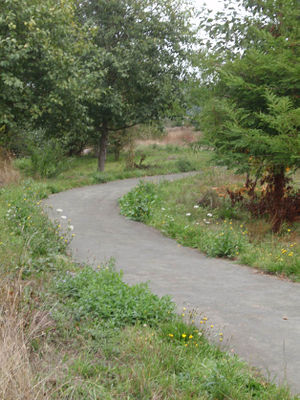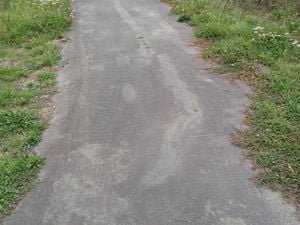
Potawot Paths
Potawot Health Village is located on 40 acres of land in Arcata, CA. Approximately one and a half miles of paths have been constructed for community enjoyment of the conservation land that surrounds the main facility. Instead of applying conventional asphalt to create walkways, Potawot chose to implement pine resin pavement in order to ease potential impact on the land. Eric Johnson, of Potawot said they chose the material because of it "is semi-impervious and is not composed of... petroleum (fossil fuel) based contaminate[s] [that will] runoff into our wetlands harming invertebrates and other organisms and groundwater."
Material Description: Pine Resin Pavement
- The material
The pine resin paths at Potowat, as shown in Figure. 1, is composed of a combination of regular aggregate, or crushed rock, sealed together with pine resin and pitch from pine trees (Product Review, 1999).
- How it is Processed
This natural alternative to asphalt isn’t mixed and poured hot as regular asphalt is, but instead mixed together through a cold process. Water and the pine emulsion are mixed and then laid where it is needed. The mixture is then compacted and set using conventional methods, such as steamrollers in larger areas. Installation in Potawot was done by hiring a local construction company, "Hooven and CO. who then subcontracted with Mercer Frasier to lay the pavement"(Eric, 2008). Instead of the product setting by cooling, it sets through evaporation of water leaving the mixture (Product Review, 1999).
- The final product
Much of the energy required to lay normal asphalt is avoided because the mixture does not have to be heated up, saving fossil fuel resources. Also, because the adhesive material is made of tree resin rather than normal petroleum based asphalt, the pavement doesn’t contain any volitile pertroleum based chemicals. (Product Review 1999) The final product is similar in appearance to asphalt in texture and thickness but can vary in color. The pine resin is transparent and takes the color of the aggregate.
Durability

The strength of pine resin pavement varies due to the quality of application, site location and actual pine resin product used. NaturalPave XL, a pine resin distributor uses the Marshall Stability Test to quantify product quality. This test heats up the pavement to 140 F and then observes how the pavement responds when a heavy weight is applied. NaturalPAVE XL withstanded "8,000 to 18,000 pounds" (NaturalPAVE XL, 2008). Typical Marshall Stability results for conventional asphalt are generally 4,000 to 6,000 pounds.
Other studies have claimed that resin pavement has three times the compressive strength(Product Review, 1999 yet there are still issues with any pavement you place on unstable soil. The Potawot paths are constructed on unstable wetland soil which as you can see in Fig. 2 have produced slight cracks in the pavement that had to be fixed.
Cost
According to the EPA, Resin Pavements cost $3/square foot for the material and installation. The project at Potawot total cost was $6/sq. foot. Eric Johnson reported the material itself costed $3/sq. foot and installation of the pavement by a local company resulted in another $3/sq. foot.
Comparison to Conventional Asphalt
Asphalt is the most conventional pavement material in our current society and may be cheaper and easier in the short run. Asphalt paving costs $1-5/ sq. foot including installation(Costhelper.com). Many asphalt paving companies exist and it is convienant to schedule a project.
Asphalt may be cost effective in the shorterm but it also has negative externalities associated with it as well. Since it is a hot mix, it takes energy from fossil fuels to heat it up. Once it is heated it emits harmful air pollutants into the air, such as formaldehyde. (EPA, 2003) Asphalt is a impervious material, meaning it does not let water filter through. This diverts rainwater directly into storm drains which lead to runoff of petrochemicals from the pavement to bodies of water, polluting water as well.
Pine resin pavement is an appropriate alternative for asphalt. Pine resin also has benifits and shortcomings and they are listed in the table below.
| Advantages | Disadvantages |
|---|---|
| High solar reflectivity: it reflects more sunlight so the pavement absorbs less heat. | Limited to use to low traffic areas |
| Not composed of petroleum products | High cost |
| Materials are natural and renewable | Labor intensive |
| Application is not as energy intensive as conventional asphalt | Certain outdoor temperatures are needed for proper finishing |
| Emits less air pollution | Technology is new, product and information are hard to find |
Links to other pine resin projects
References
- Johnson, Eric. Email. Dec. 2, 2008.
- Dooley, Erin E. “New Default for Asphalt?” Environmental Health Perspectives vol.116, no 9, pg 379, 2008.
- “Paving Without Asphalt or Concrete”Product Review: Environmental Building News. Nov. 1, 1999.
- NaturalPAVE® XL “Technical Bulletin-Pavement Preformance Testing.” Soil Stabilization Products Company, Inc.
- NaturalPAVE® XL “An aesthetic, environmentally friendly alternative to asphalt”. Soil Stabilization Products Company, Inc.
- "Resin Pavement: Cool Pavement Product Information" Environmental Protection Agency, US Government.Oct. 2008. [1]
- "National Emission Standards for Hazardous Air Pollutants: Asphalt Processing and Asphalt Roof Manufacturing" Environmental Protection Agency, US Government Federal Register. May 17, 2003 [2]